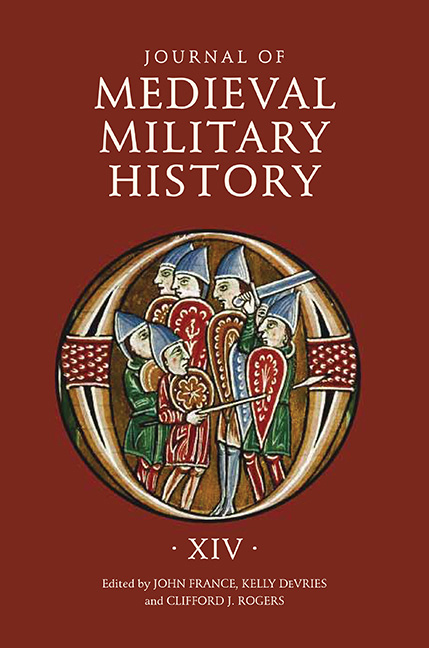Book contents
- Frontmatter
- Contents
- 1 Anglo-Norman Artillery in Narrative Histories, from the Reign of William I to the Minority of Henry III
- 2 Imperial Policy and Military Practice in the Plantagenet Dominions, c. 1337–c. 1453
- 3 The Parliament of the Crown of Aragon as Military Financier in the War of the Two Pedros
- 4 Chasing the Chimera in Spain: Edmund of Langley in Iberia, 1381/82
- 5 Note: A Medieval City under Threat Turns Its Coat, while Hedging Its Bets – Burgos Faces an Invasion in Spring 1366: Introduction and Translation
- 6 Medieval European Mercenaries in North Africa: The Value of Difference
- 7 Medieval Irregular Warfare, c. 1000–1300
- 8 Muslim Responses to Western Intervention: A Comparative Study of the Crusades and Post-2003 Iraq
- 9 “New Wars” and Medieval Warfare: Some Terminological Considerations
- 10 Friend or Foe? The Catalan Company as Proxy Actors in the Aegean and Asia Minor Vacuum
- List of Contributors
- Journal of Medieval Military History
- De Re Militari and the Journal of Medieval Military History
5 - Note: A Medieval City under Threat Turns Its Coat, while Hedging Its Bets – Burgos Faces an Invasion in Spring 1366: Introduction and Translation
Published online by Cambridge University Press: 12 September 2017
- Frontmatter
- Contents
- 1 Anglo-Norman Artillery in Narrative Histories, from the Reign of William I to the Minority of Henry III
- 2 Imperial Policy and Military Practice in the Plantagenet Dominions, c. 1337–c. 1453
- 3 The Parliament of the Crown of Aragon as Military Financier in the War of the Two Pedros
- 4 Chasing the Chimera in Spain: Edmund of Langley in Iberia, 1381/82
- 5 Note: A Medieval City under Threat Turns Its Coat, while Hedging Its Bets – Burgos Faces an Invasion in Spring 1366: Introduction and Translation
- 6 Medieval European Mercenaries in North Africa: The Value of Difference
- 7 Medieval Irregular Warfare, c. 1000–1300
- 8 Muslim Responses to Western Intervention: A Comparative Study of the Crusades and Post-2003 Iraq
- 9 “New Wars” and Medieval Warfare: Some Terminological Considerations
- 10 Friend or Foe? The Catalan Company as Proxy Actors in the Aegean and Asia Minor Vacuum
- List of Contributors
- Journal of Medieval Military History
- De Re Militari and the Journal of Medieval Military History
Summary
Introduction
Despite the traditional image of the heavily armored knight on horseback, lance couched, charging recklessly into the fray, it has become a well-established truism of medieval military history that typical large-scale military activity in the period involved a siege rather than a set-piece battle. While battles did indeed occur, sieges conducted against castles, towns, and cities far surpassed them in number.
If a target were strong and the defenders resolute, it might well hold out indefinitely, or at least long enough to witness the disintegration of the attacking army. On the other hand, there were not-a-few instances when the place under attack was not well fortified, not adequately supplied, or simply not strongly inclined to resist the forces brought against it. In such a case, its best hope lay in reaching some kind of negotiated accommodation with the attackers that would preserve the lives, liberty, and property of its inhabitants. Upon occasion, however, such a place might feel compelled to take pains to avoid having its surrender being seen as treason by its former lord, in order that it might avoid retribution at some future date in the event that that lord managed to regain possession.
Such was the case with Burgos, the northern capital of the Iberian kingdom of Castile, when, in the spring of 1366, it was caught between two warring halfbrothers, one legitimate, the other illegitimate, both of whom were claiming the Castilian throne. Its actions on this occasion exemplify the careful path a city might have to tread in an effort to protect itself against present destruction as well as future retribution.
In March of 1366, Enrique, count of Trastámara and illegitimate son of King Alfonso XI (r. 1311–50) invaded Castile accompanied by his principal captain, Bertrand du Guesclin (d. 1380), the legendary Breton warrior who would later become constable of France and drive the English out of much the territory they had conquered in the opening stages of the Hundred Years War (1339–1453). The pair led an army, paid for by France, Aragon, and the Papacy, composed of Castilian exiles, Aragonese volunteers, and thousands of men from the Free Companies, bodies of soldiery thrown out of work by a lull in the conflict raging north of the Pyrenees. The invasion's purpose was to overthrow the reigning monarch of Castile, Pedro I, widely known as “the Cruel” (1350–66/1367–69).
- Type
- Chapter
- Information
- Journal of Medieval Military HistoryVolume XIV, pp. 99 - 104Publisher: Boydell & BrewerPrint publication year: 2016

